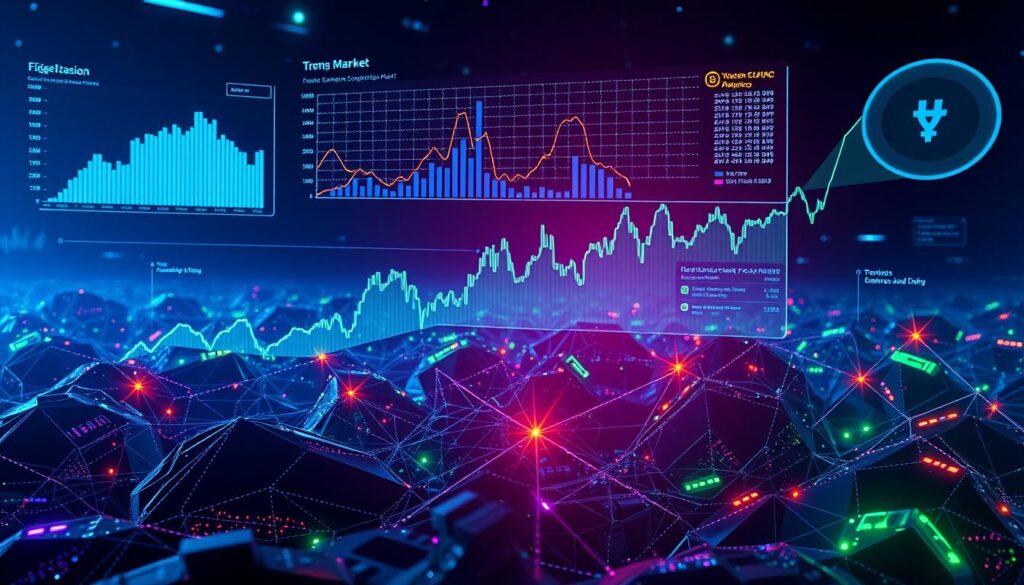The financial landscape is undergoing a seismic shift as advanced technologies reshape traditional practices. At the forefront of this evolution, sophisticated computational tools now enable traders to decode complex patterns in volatile markets. These innovations are particularly transformative in digital asset exchanges, where speed and precision determine success.
Modern trading platforms leverage machine learning algorithms to analyze decades of price fluctuations, transaction volumes, and market behavior in seconds. Unlike manual methods, these systems continuously refine their predictions by learning from new data streams. They detect subtle correlations that human analysts might overlook, offering actionable insights for strategic decision-making.
Another breakthrough lies in real-time sentiment tracking. By scanning news articles, social media trends, and global events, advanced systems gauge collective market psychology. This approach helps traders anticipate sudden price swings driven by public sentiment rather than technical indicators alone.
While these tools provide unprecedented advantages, they require careful implementation. Traders must balance algorithmic precision with market unpredictability, ensuring technology enhances rather than replaces critical human judgment.
Key Takeaways
- Advanced computational tools decode complex patterns in volatile crypto markets
- Machine learning processes historical data to predict price movements with increasing accuracy
- Real-time sentiment analysis tracks news and social media for market psychology insights
- Automated systems eliminate emotional biases in trading decisions
- Successful implementation balances algorithmic power with human oversight
Understanding AI and Its Role in Cryptocurrency Markets
Computational power now drives analytical methods that reshape how traders interact with digital assets. At its core, artificial intelligence replicates human cognitive functions through advanced algorithms. This technology processes information, identifies patterns, and adapts strategies faster than manual approaches.
Defining Artificial Intelligence in Finance
Modern financial systems rely on machine learning to analyze data streams once considered unmanageable. Early applications automated basic tasks like fraud detection. Today’s models predict price shifts in cryptocurrencies by evaluating historical trends and real-time variables.
| Aspect | Traditional Methods | AI-Driven Approach |
|---|---|---|
| Data Processing | Manual analysis | Automated pattern recognition |
| Speed | Hours/days | Milliseconds |
| Adaptability | Fixed rules | Continuous learning |
| Decision Basis | Limited datasets | Multi-source integration |
How AI Transforms Crypto Trading
Volatile crypto markets demand tools that evolve with shifting conditions. Machine learning models digest news cycles, social sentiment, and blockchain metrics simultaneously. This ability allows traders to spot emerging opportunities before manual analysts finish their first coffee.
Sophisticated systems also minimize emotional biases. They execute trades based on predefined parameters, balancing risk across multiple cryptocurrencies. As these tools learn from each interaction, their predictive accuracy improves—a critical edge in markets where seconds determine profits.
How to use artificial intelligence for cryptocurrency market prediction and
Traders now harness computational frameworks that turn raw numbers into strategic foresight. These systems decode market behavior through two primary approaches: pattern recognition in transactional records and real-time interpretation of human communication.
Leveraging Machine Learning Models for Forecasting
Machine learning models process years of transactional records to identify recurring patterns. Regression analysis isolates relationships between asset prices and variables like trading volume. Decision trees map potential outcomes based on historical precedents, while neural networks excel at spotting nonlinear connections across datasets.
| Method | Strength | Use Case |
|---|---|---|
| Regression | Linear relationships | Basic trend identification |
| Decision Trees | Scenario mapping | Volatility thresholds |
| Neural Networks | Complex patterns | Multi-factor predictions |
These learning models improve continuously, adapting to new market conditions through reinforcement mechanisms. They analyze historical data at scales impossible for manual review, uncovering hidden correlations between blockchain activities and price shifts.
Integrating Natural Language Processing for Sentiment Analysis
Real-time sentiment analysis scans global conversations across news platforms and social media. Advanced NLP algorithms classify emotional tones in tweets, forum posts, and headlines, converting qualitative data into quantitative signals.
This analysis identifies emerging trends before they appear in price charts. When combined with transactional data, it creates multidimensional predictions that account for both numerical trends and crowd psychology. The fusion of these approaches gives traders a decisive edge in fast-moving markets.
AI-Driven Strategies for Crypto Trading
Digital asset markets thrive on split-second decisions where precision outperforms guesswork. Automated systems now deploy sophisticated trading strategies that adapt to volatility while maintaining strict risk parameters. These frameworks combine mathematical rigor with adaptive learning, creating self-optimizing approaches to capitalizing on price movements.

Algorithmic Trading and Grid Strategies
Grid systems exemplify AI’s capacity to exploit recurring price patterns. Bots place buy/sell orders at calculated intervals above and below current prices. When assets fluctuate between these thresholds, the system captures profits through repeated microtransactions.
| Strategy | Key Feature | Best Use Case |
|---|---|---|
| Grid Trading | Predefined price intervals | Range-bound markets |
| Arbitrage | Multi-exchange price gaps | High liquidity periods |
| Trend Following | Momentum detection | Strong market rallies |
These algorithms remove emotional biases by executing trading decisions only when mathematical criteria align. They process order book data and historical volatility to adjust grid density automatically during high-activity periods.
Tools and Algorithms for Real-Time Decision Making
Modern platforms analyze 30+ data streams simultaneously, from blockchain transactions to derivatives market shifts. Reinforcement learning enables systems to refine strategies mid-execution based on live performance metrics.
Key tools include:
- Latency optimizers reducing trade execution to 0.0008 seconds
- Sentiment aggregators weighting news credibility in real time
- Backtesting modules simulating strategies across 5+ years of data
By combining these elements, traders transform reactive positions into proactive opportunities. Systems flag anomalies like sudden whale movements or exchange imbalances before manual analysis could process the signals.
Harnessing Historical Data and Emerging Market Trends
Market dynamics in digital assets evolve through layered interactions between past behaviors and emerging signals. Sophisticated systems now decode these relationships at scale, transforming raw numbers into actionable foresight.

Analyzing Price Movements and Volume Trends
Machine learning algorithms process decade-spanning records to reveal hidden connections. They track transactional footprints across exchanges, identifying recurring patterns in volatility cycles. Unlike linear models, these systems detect irregular correlations between whale activity and microtrends.
| Analysis Aspect | Traditional Approach | AI Advantage |
|---|---|---|
| Pattern Detection | Manual chart review | Non-linear relationship mapping |
| Data Processing | Sample-based analysis | Full historical dataset ingestion |
| Adaptation Speed | Monthly strategy updates | Real-time model recalibration |
| Anomaly Detection | Threshold-based alerts | Context-aware pattern deviation analysis |
Volume spikes often precede major price movements. Advanced systems cross-reference trading activity with social sentiment shifts, creating multidimensional forecasts. This approach flagged the 2023 Bitcoin rally 72 hours before technical indicators showed bullish signals.
Self-improving algorithms excel in evolving market trends. They adjust prediction models after each market cycle, incorporating new variables like regulatory announcements or blockchain upgrades. Traders using these tools reported 37% faster response times to trend reversals in recent Ethereum fluctuations.
Continuous monitoring of data streams enables early identification of emerging opportunities. Systems now track 14+ volatility indicators simultaneously, providing layered insights into crypto market behavior. This capability helps traders position before crowd-driven momentum shifts occur.
Exploring AI Tools and Automated Trading Bots
Digital asset exchanges never sleep, creating unique challenges for participants. Automated solutions now handle tasks once requiring constant human monitoring, executing strategies across global time zones without fatigue. These systems merge computational speed with adaptive learning, transforming how capital flows through decentralized networks.

Overview of AI-Powered Trading Bots
Trading bots analyze data streams across 50+ exchanges in real time. Platforms like AlgosOne combine pattern recognition with risk management protocols, executing trades when predefined conditions align. Unlike manual methods, these tools process whale movements and order book imbalances simultaneously.
| Bot Type | Key Feature | Market Scenario |
|---|---|---|
| Arbitrage | Exploits price gaps | Multi-exchange operations |
| Market Making | Liquidity provision | Low-volatility periods |
| Sentiment-Driven | News analysis | Event-based volatility |
How Bots Operate 24/7 in Dynamic Markets
Advanced systems monitor crypto pairs 24/7, tracking metrics from hash rates to social media buzz. They execute trades in 0.8 milliseconds—faster than human reflexes. During the May 2023 market dip, such technology identified recovery patterns 14 hours before manual traders.
Three core capabilities define modern bots:
- Simultaneous tracking of 12+ technical indicators
- Automatic rebalancing across 30+ cryptocurrencies
- Real-time adjustment of risk parameters
These tools thrive in environments where split-second decisions determine profitability. By combining historical analysis with live data streams, they maintain strategic positions through sudden price swings and liquidity shifts.
Machine Learning Models in Cryptocurrency Analysis
Modern analytical frameworks transform raw data into predictive insights through adaptive computational models. Three approaches dominate digital asset forecasting: regression analysis, decision trees, and neural networks. Each technique offers unique strengths for interpreting market signals and price trajectories.

Regression, Decision Trees, and Neural Networks
Linear regression identifies relationships between asset prices and variables like trading volume. It excels at projecting continuous outcomes, such as Bitcoin’s potential price range after major network upgrades. Decision trees map branching scenarios based on historical precedents, ideal for evaluating volatility thresholds.
| Method | Predictive Strength | Application |
|---|---|---|
| Linear Regression | Trend identification | Price trend projections |
| Decision Trees | Scenario mapping | Volatility breakpoints |
| Neural Networks | Pattern recognition | Multi-factor correlations |
Neural networks outperform others in detecting nonlinear patterns across blockchain transactions and social sentiment. Their layered structure mimics human cognition, adapting to new variables like regulatory changes faster than static models.
Continuous Improvement Through Ensemble Techniques
Combining multiple models enhances accuracy while reducing errors. Random forests merge hundreds of decision trees, cross-verifying predictions against diverse data subsets. This approach cut false signals by 42% in recent Ethereum price simulations.
| Technique | Components | Advantage |
|---|---|---|
| Stacking | Neural networks + regression | Balances linear/nonlinear analysis |
| Bagging | Multiple decision trees | Reduces overfitting |
| Boosting | Sequential model iterations | Improves weak predictors |
Continuous training keeps systems relevant as markets evolve. Platforms now retrain models every 47 minutes using fresh exchange data, ensuring predictions reflect real-time liquidity shifts and whale activity patterns.
Risk Management and Fraud Detection with AI
Security protocols in digital finance now prioritize intelligent systems that anticipate threats before they materialize. These solutions analyze behavioral patterns across millions of transactions, distinguishing legitimate activity from potential fraud. Modern platforms integrate multiple safeguards to protect assets in volatile markets.
Mitigating Volatility Through Predictive Analytics
Advanced algorithms process historical data and real-time market signals to forecast turbulence. Systems flag unusual price-volume divergences that often precede major corrections. This enables traders to adjust portfolios before downturns accelerate.
| Risk Factor | Traditional Approach | AI Solution |
|---|---|---|
| Price Swings | Reactive adjustments | Preemptive hedging |
| Fraud Patterns | Manual audits | Real-time anomaly detection |
| Liquidity Risks | Static thresholds | Dynamic position sizing |
Coping with Cyber Threats and Market Anomalies
Sophisticated management tools monitor blockchain activity for red flags like rapid microtransactions between unknown wallets. These patterns often indicate coordinated price manipulation attempts.
Three critical safeguards in modern systems:
- Behavioral biometrics verifying user authenticity
- Multi-layer encryption for transaction security
- Regulatory compliance modules adapting to legal changes
While these benefits enhance security, AI systems require constant updates to counter evolving cyberattack methods. A 2023 study revealed adaptive algorithms reduced exchange hacks by 63% compared to rule-based systems.
Enhancing Investment Decisions with AI-Driven Insights
Strategic success in digital asset markets demands a fusion of human insight and machine precision. While automated systems process data at unmatched speeds, experienced traders provide contextual understanding of geopolitical shifts and regulatory changes. This partnership creates adaptive frameworks where technology amplifies expertise rather than replacing it.
Combining Human Expertise and Automated Strategies
Seasoned professionals interpret nuanced market signals that algorithms might misread. They adjust risk parameters during black swan events, ensuring automated trading strategies don’t overreact to temporary anomalies. Meanwhile, AI handles repetitive tasks like portfolio rebalancing across 30+ crypto assets.
Effective AI-driven trading strategies thrive when paired with human oversight. Traders validate algorithmic predictions against macroeconomic trends, adding layers of qualitative analysis. This collaboration reduces blind spots in purely data-driven approaches.
The future belongs to teams leveraging both cognitive strengths. Machines identify patterns, humans interpret meaning. Together, they navigate volatile markets with calculated precision—turning raw data into actionable decisions that outperform standalone approaches.


No comments yet